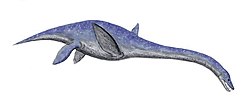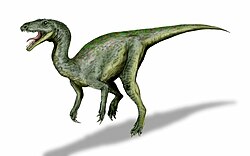| Name | Status | Novelty | Authors | Age | Unit | Location | Notes | Images |
|---|
Aramus paludigrus [23] | Sp. nov. | Valid | D. Tab Rasmussen | Miocene | Honda Group |  Colombia Colombia
| An Aramidae. | |
Athene angelis [24] | Sp. nov. | Valid | Cécile Mourer-Chauviré Michelle Salotti Elizabeth Pereira Yves Quinif Jean-Yves Courtois Jean-Noël Dubois Jean-Claude La Milza | Middle Pleistocene | Corsica |  France: France:
 Corsica Corsica
| A Strigidae. | |
Cathayornis caudatus [25] | Sp. nov. | Valid | Hou Lianhai | Early Cretaceous | Valanginian, Jiufotang Formation |  China China
| A member of Enantiornithes Walker, 1981. Originally described as a species of Cathayornis ; [25] subsequently made the type species of a separate genus Houornis. [26] | |
Chauvireria balcanica [27] | Gen. nov. et Sp. nov. | Valid | Zlatozar N. Boev | Late Pliocene | MN 17 |  Bulgaria Bulgaria
| A Phasianidae. | |
Confuciusornis chuonzhous [25] | Sp. nov. | Valid ? | Hou Lianhai | Early Cretaceous | Lower Yixian Formation |  China China
| A Confuciusornithidae Hou, Zhou, Gu et Zhang, 1995, possibly a synonym of Confuciusornis sanctus L. H. Hou, Zhou, Gu et Zhang, 1995. | |
Confuciusornis suniae [25] | Sp. nov. | Valid ? | Hou Lianhai | Early Cretaceous | Lower Yixian Formation |  China China
| A Confuciusornithidae Hou, Zhou, Gu et Zhang, 1995, possibly a synonym of Confuciusornis sanctus L. H. Hou, Zhou, Gu et Zhang, 1995. | |
Cuspirostrisornis houi [25] | Gen. nov et Sp. nov. | Valid | Hou Lianhai | Early Cretaceous | Valanginian, Jiufotang Formation |  China China
| An Enantiornithes Walker, 1981, Cuspirostrisornithidae Hou, 1997, this is the type species of the new genus. | |
Eutreptodactylus itaboraiensis [28] | Gen. nov. et Sp. nov. | Valid | Robert F. Baird Patricia Vickers Rich | Late Paleocene | Sao Jose de Itaborai |  Brazil Brazil
| Described in the Cuculidae, transferred to the Gracilitarsidae Mayr, 2001 by Mayr. | |
Galbula hylochoreutes [23] | Sp. nov. | Valid | D. Tab Rasmussen | Miocene | La Victoria Formation |  Colombia Colombia
| A Galbulidae. | |
Heliadornis paratethydicus [29] | Sp. nov. | Valid | Jirí Mlíkovský | Late Pliocene | MN 15-16 |  Slovakia Slovakia
| A Phaethontidae. | |
Largirostrornis sexdentoris [25] | Gen. nov et Sp. nov. | Valid | Hou Lianhai | Early Cretaceous | Valanginian, Jiufotang Formation |  China China
| An Enantiornithes Walker, 1981, Cuspirostrisornithidae Hou, 1997, this is the type species of the new genus. | |
Liaoningornis longidigitris [30] | Gen. nov et Sp. nov. | Valid | Hou Lianhai | Early Cretaceous | Yixian Formation |  China China
| An Enantiornithes Walker, 1981, Liaoningornithiformes L. H. Hou, 1997, Liaoningornithidae Hou, 1997, this is the type species of the new genus. | |
Longchengornis sanyanensis [25] | Gen. nov et Sp. nov. | Valid | Hou Lianhai | Early Cretaceous | Valanginian, Jiufotang Formation |  China China
| An Enantiornithes Walker, 1981, Cuspirostrisornithidae Hou, 1997, this is the type species of the new genus. | |
Pasquiaornis hardiei [31] | Gen. nov. et Sp. nov. | Valid | Tim T. Tokaryk Stephen L. Cumbaa John E. Storer | Early Cretaceous | Cenomanian, Ashville Formation |  Canada: Canada:
 Saskatchewan Saskatchewan
| An Hesperornithiformes Fürbringer, 1888, Baptornithidae American Ornithologists’ Union, 1910, this is the type of the new genus. | |
Pasquiaornis tankei [31] | Gen. nov. et Sp. nov. | Valid | Tim T. Tokaryk Stephen L. Cumbaa John E. Storer | Early Cretaceous | Cenomanian, Ashville Formation |  Canada: Canada:
 Saskatchewan Saskatchewan
| An Hesperornithiformes Fürbringer, 1888, Baptornithidae American Ornithologists’ Union, 1910. | |
Pleistorallus flemingi [32] | Gen. nov. et Sp. nov. | Valid | Trevor H. Worthy | Pleistocene | Wanganui Subdivision |  New Zealand New Zealand
| A Rallidae. | |
Rhynchopsitta phillipsi [33] | Sp. nov. | Valid | Amadeo M. Rea | Late Pleistocene | Cave Deposits |  Mexico Mexico
| A Psittacidae. | |
Rupelrallus saxoniensis [34] | Gen. nov et Sp. nov. | Valid | Karlheinz Fischer | Middle Oligocene | MP 23-24 |  Germany: Germany:
 Saxony Saxony
| A Gruiformes, Parvigruidae G. Mayr, 2005. | |
Songlingornis linghensis [25] | Gen. nov et Sp. nov. | Valid | Hou Lianhai | Early Cretaceous | Valanginian, Jiufotang Formation |  China China
| An Ornithuromorphae Chiappe, Ji, Ji et Norell, 1999, Songlingornithidae Hou, 1997, this is the type species of the new genus. | |
Vanellus madagascariensis [35] | Sp. nov. | Valid | Steven M. Goodman | Holocene | Madagascar |  Madagascar Madagascar
| A Charadriidae. | |
Urmiornis brodkorbi [36] | Sp. nov. | Valid | Aleksandr A. Karkhu | Early Miocene | Lower Tarkhanian-Burdigalian? |  Kazakhstan Kazakhstan
| An Eogruidae Wetmore, 1934, perhaps should be transferred to the genus Amphipelargus Lydekker, 1891. | |
|












